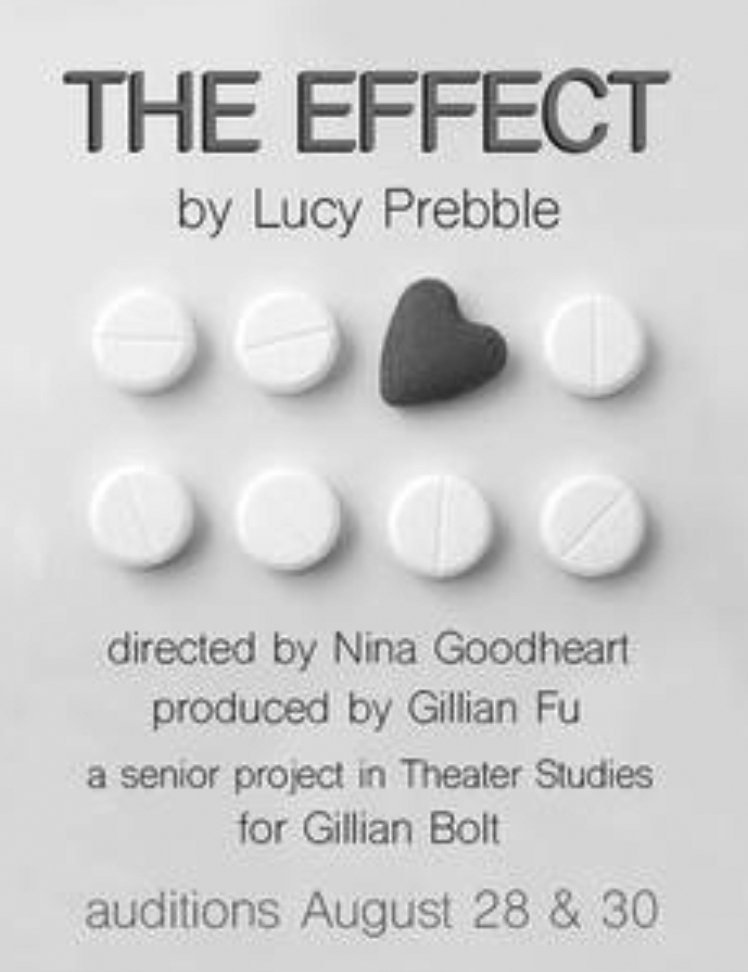
Yale College Arts
“Love is double blind.”
As is the tag line for “The Effect” by Lucy Prebble, a senior project in Theater Studies for Gillian Bolt ’19. “The Effect” will run this Thursday through Saturday at the Whitney Humanities Theater.
Bolt plays Connie Hall, a woman who is 26 years old, weighs 55 kilograms and is 163 centimeters tall. At home, she has a boyfriend who is a professor with a young son. Bolt flickers between passionate and practical, embodying the indecisive nature of her character, Connie. Complementing Bolt is Sammy Grob ’20, who plays Tristan Frey, a charming 30-year-old who weighs 80 kilograms and is 173 centimeters tall. They were both born on Sept. 29. Tristan is searching for something, and he thinks he may have found it.
Tristan’s attraction toward Connie is immediate and playful and becomes more powerful with each dose. They bond throughout their prolonged time in the facility, learning small bits about each other which only draw them closer. Simultaneously, however, their dosages increase and they are reminded each day of their roles as test subjects in a larger experiment. The independent variable? Treatment with antidepressants, or a placebo. As the two subjects fall in love, they begin to wonder if their heightened senses and quickened heartbeats are side effects rather than reality. Bolt and Grob have such intense and undeniable chemistry, and their portrayal of two star-crossed lovers is both convincing and joyful. I found myself cheering for them, from the strange yet simple grasp of a urine sample to the very first drag of a cigarette, through to the end.
My feelings of elation and hope for the young couple were at once deflated as I watched them struggle to reconcile with the reality of the experiment and what that truth means. My heartbreak was compounded by the fact that I, too, was struggling to capture what was real and what was “the effect.”
Nina Goodheart ’19 lends her extensive theater experience to the production in the role of the director. Each action is executed with precise detail, from the blocking to each character’s quirks. In combination with Goodheart’s direction, the actors bring fascinating instincts to each character. Tristan has a nervous tick and is almost never still; whether it’s shaking his leg as he sits or snapping his fingers and clapping his hands when forced to stand in one place. Connie, on the other hand, incessantly bites her fingernails, which Tristan notices in an adorable moment.
The other half of the trial includes Dr. James, played by Aïssa Guindo ’21, and Toby, played by Lukas Cox ’19. The tension between Dr. James and Toby is both measurable yet clearly dangerous, which Goodheart balances masterfully as their body language toward one another changes. Goodheart tests the established boundary of the set and the trial, her intent made clear as the actors move about the space, and at times away from each other.
While the individual performance of each actor was breathtaking, Guindo’s execution of Dr. James was perhaps the most impressive; Guindo held a poised authority in her role as the administrator of the trial, demonstrating a controlled yet unconquerable yearning in her pursuit of the truth. The trial has a larger effect on Dr. James than even she realizes, and Guindo portrays this heartbreaking internal struggle with careful complexity. Without a doubt, none of the four are left unaffected by the show’s end.
The set of “The Effect” is simple and clean, designed by Kristine Sungyeon Chung ’19. A large white wall accompanied by a section of the floor painted white forms what appears to be a large cubic scene waiting to be adapted into a sterile lab or a hospital room.
Despite the daunting vastness of this polished ivory expanse of space, the set provides a perfect canvas for elaborate lighting and projections, designed by Emma Levine ’20 and Ryan Seffinger ’19, respectively. In one moment, the world in which the characters are confined for the trial explodes into an exploration of their own neuro map; at one point, the walls are suddenly covered in bending tetrahedrons. This particular design element coupled with loud bursts of noise may seem jarring at first, but I, along with the rest of the audience, was absolutely mesmerized. The projections create an ethereal and overtly technological air — these images compensate tenfold for the lack of actual medical equipment and contribute to the minimalistic set design.
The Whitney Theater seats 61 despite its high ceilings and vast floor space, making the experience feel extremely intimate — the audience is able to laugh, cry and feel shocked together. During periods of calm, there is a collective exhale among us.
Having read the script before watching the show, I thought I was aware of what I was walking into. However, I soon realized that attaching bodies to the conditions of this world would create its own effect on me. Emotional and submerged in the washed-out, white and crumpled bedsheets, I left 100 minutes later feeling submerged in a swirling hope and light.
Alexus Coney | alexus.coney@yale.edu .







